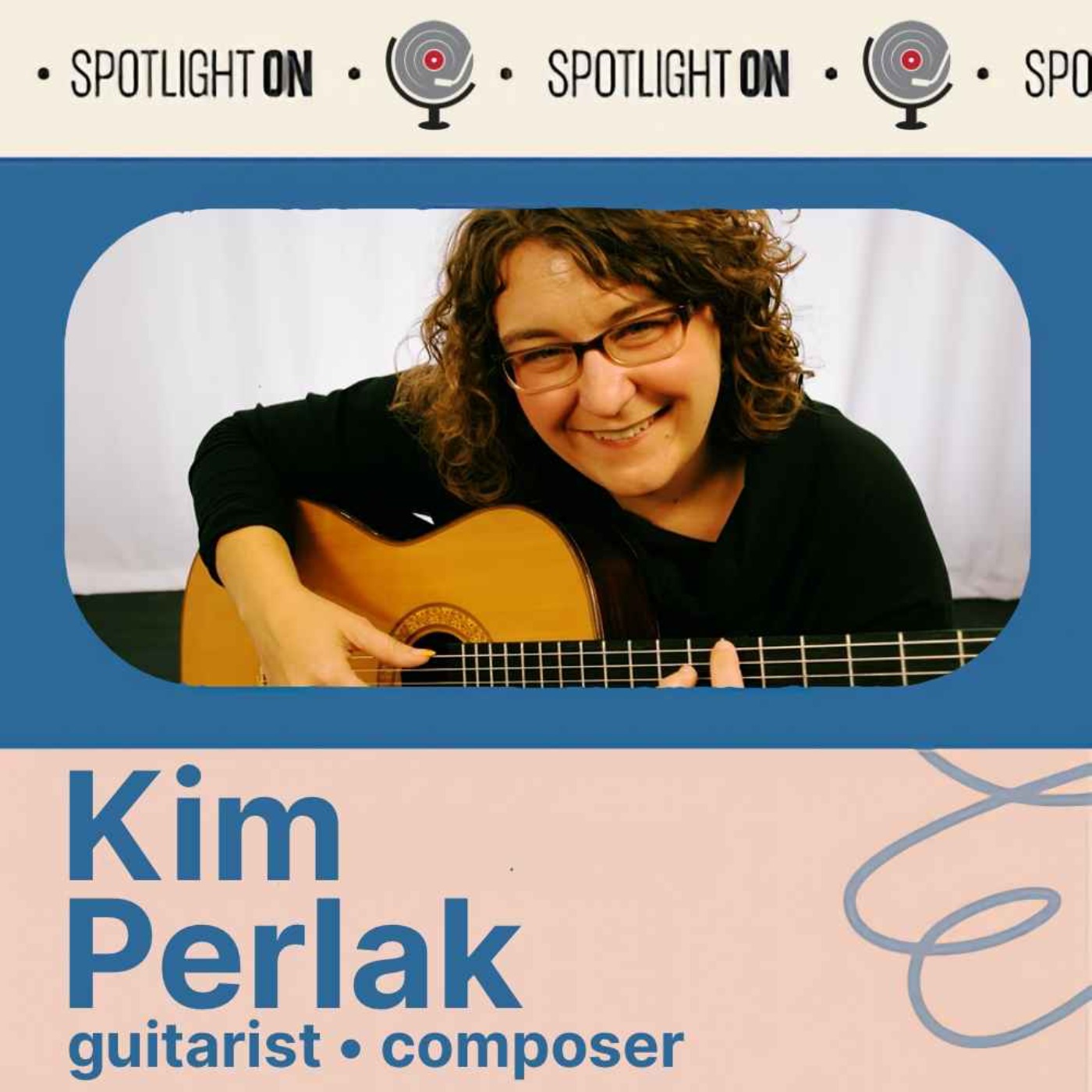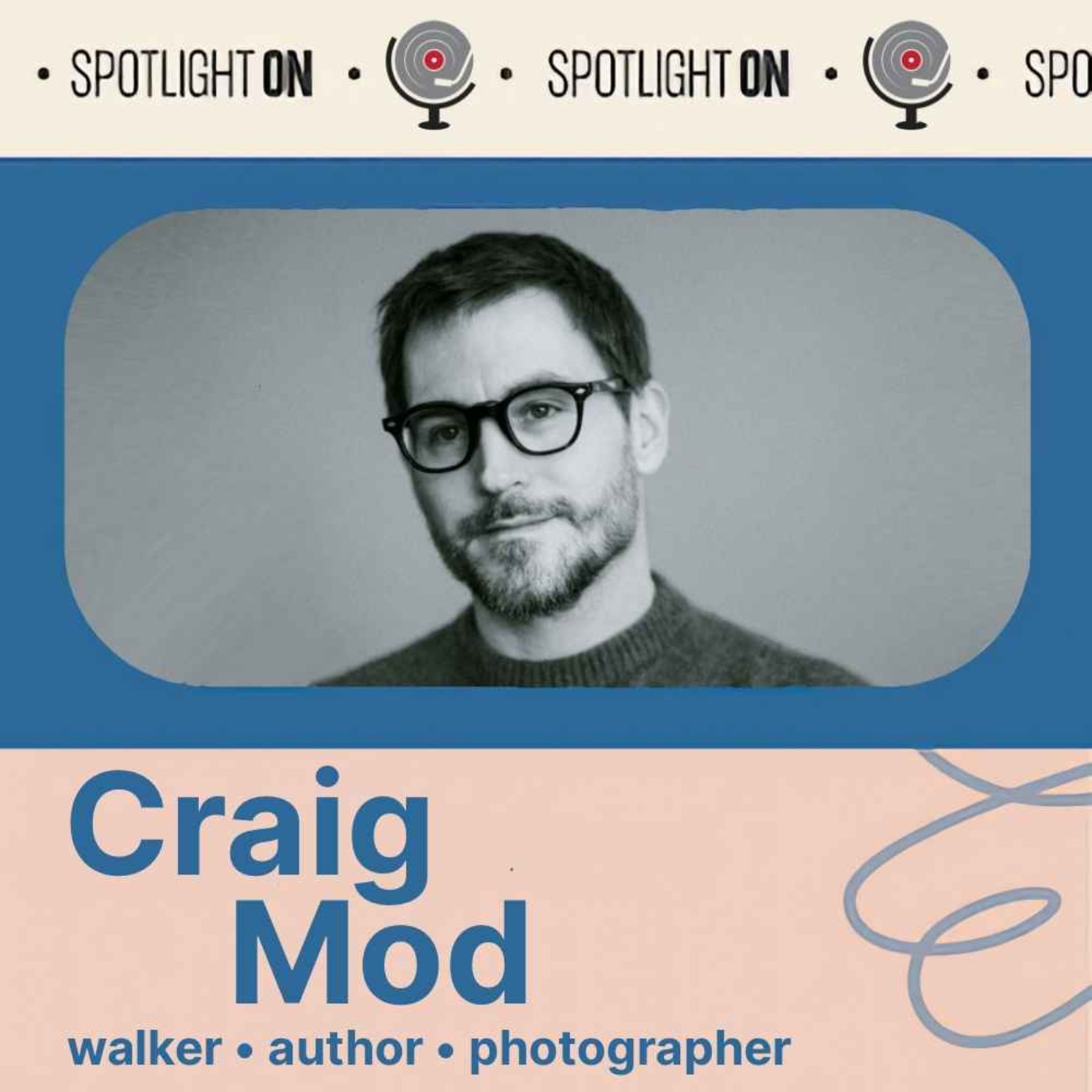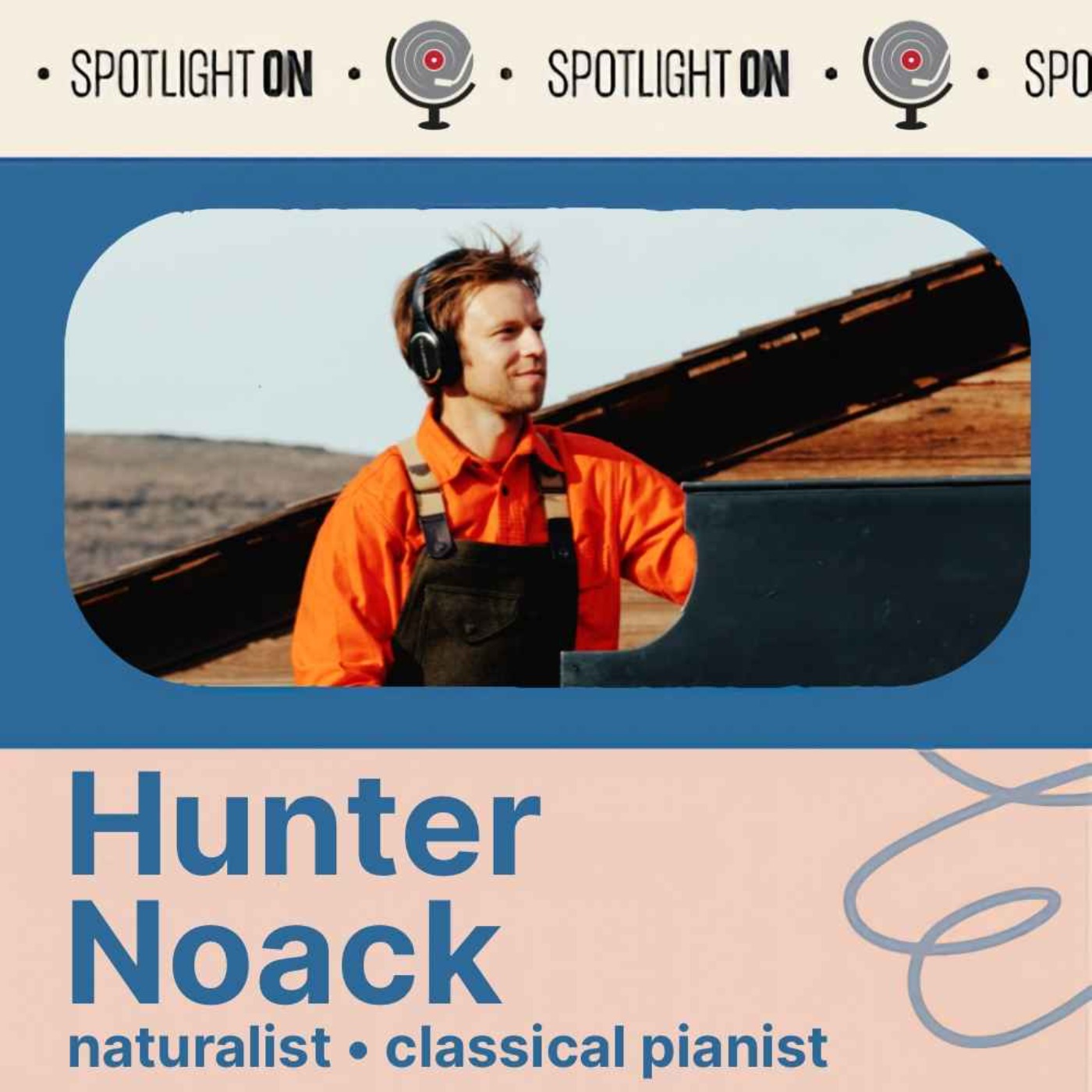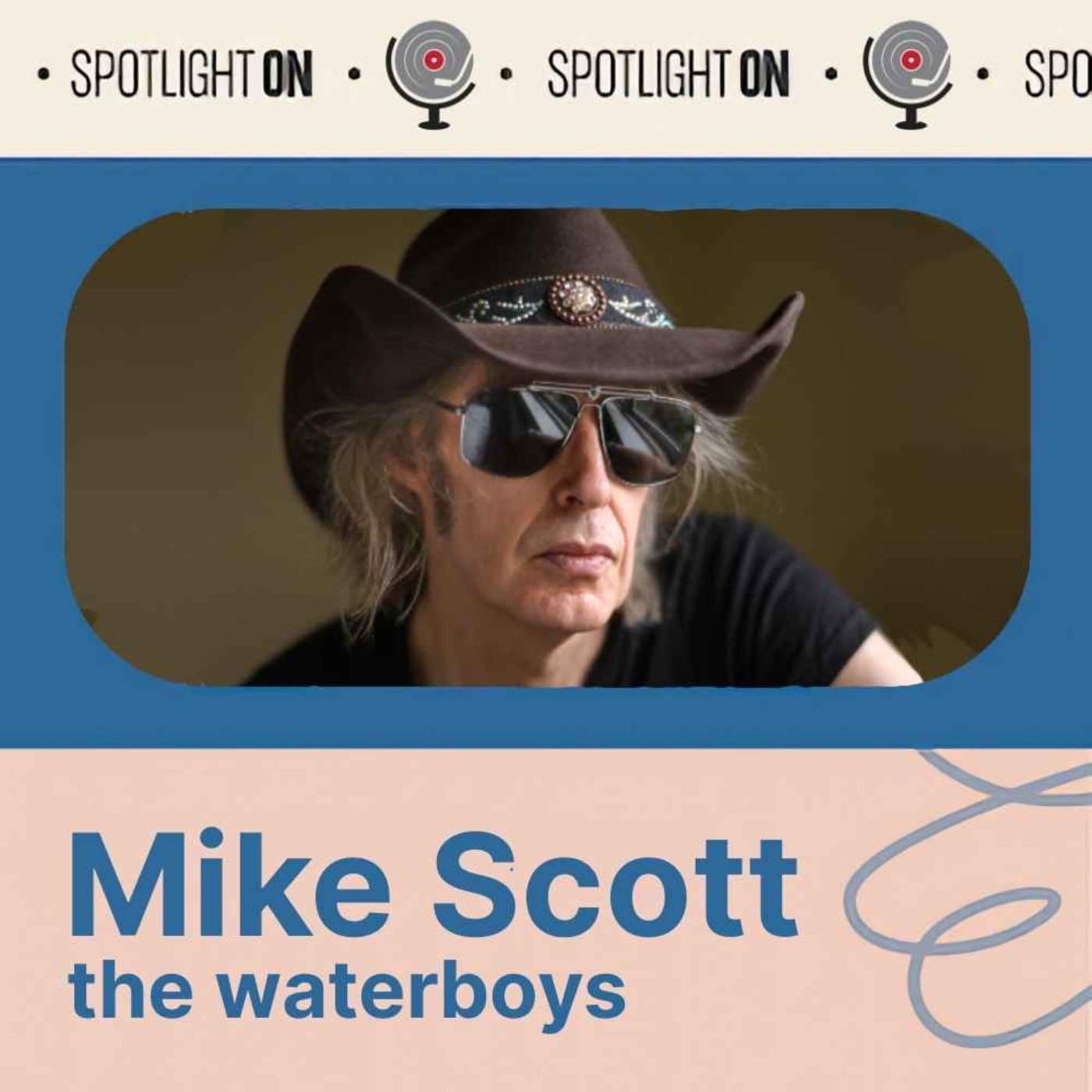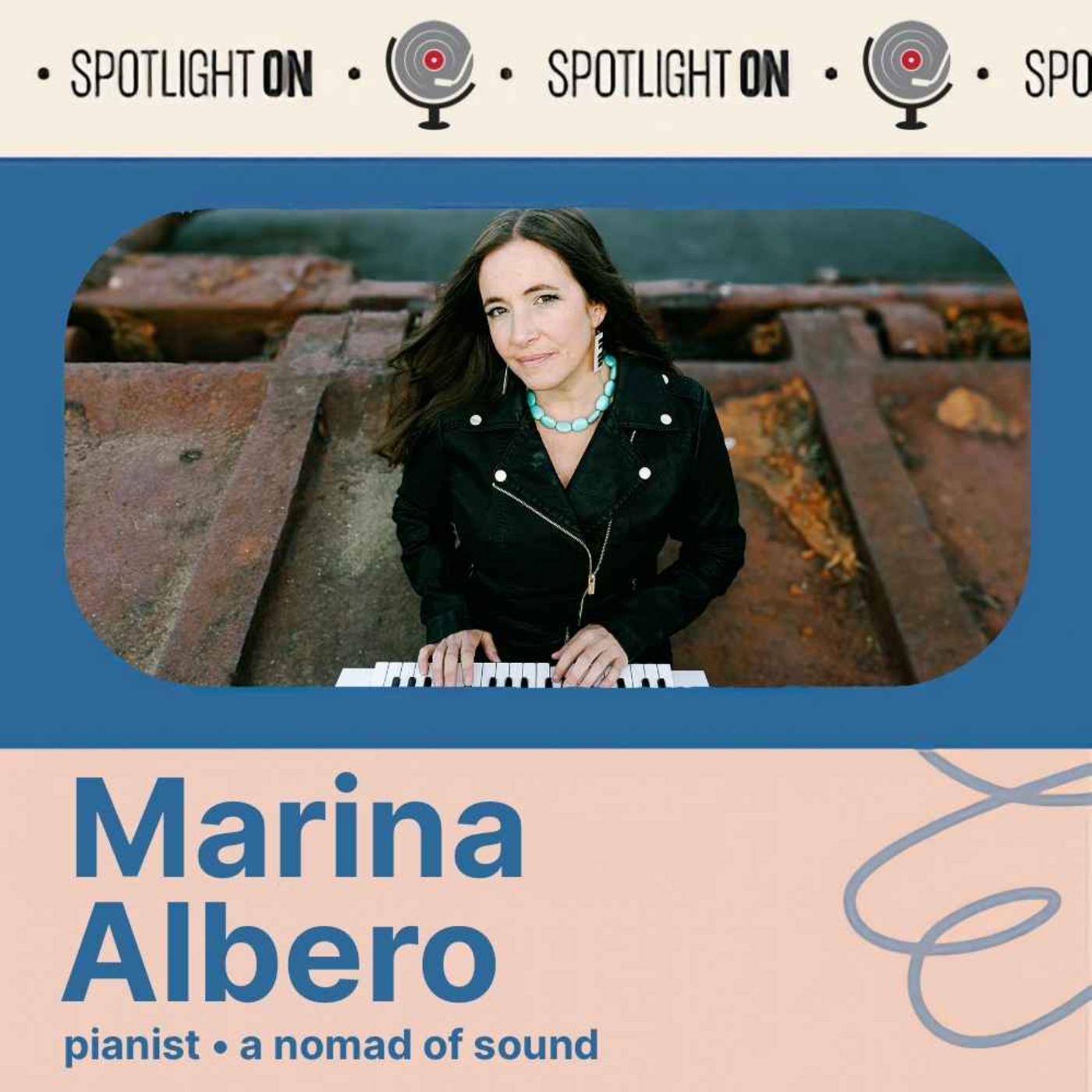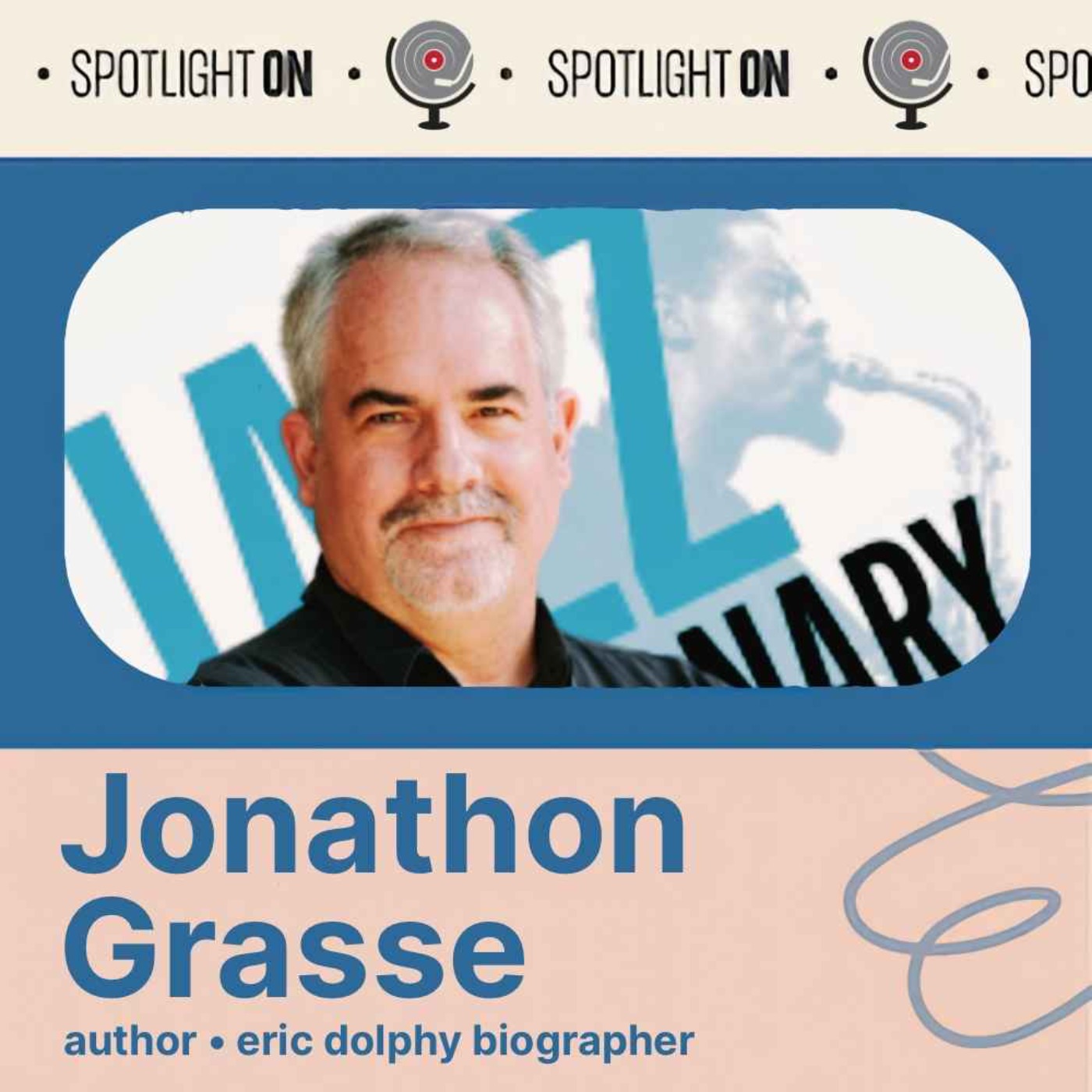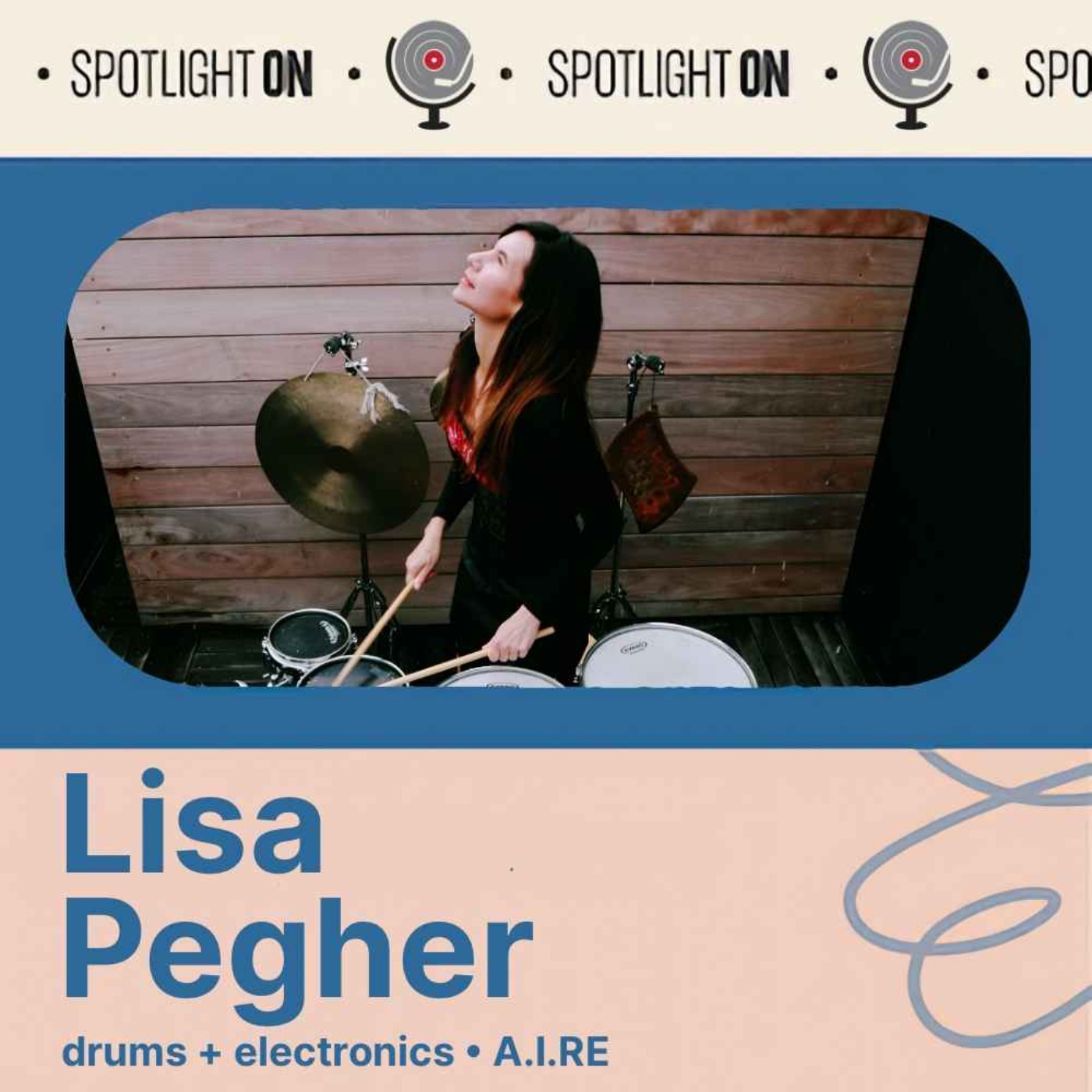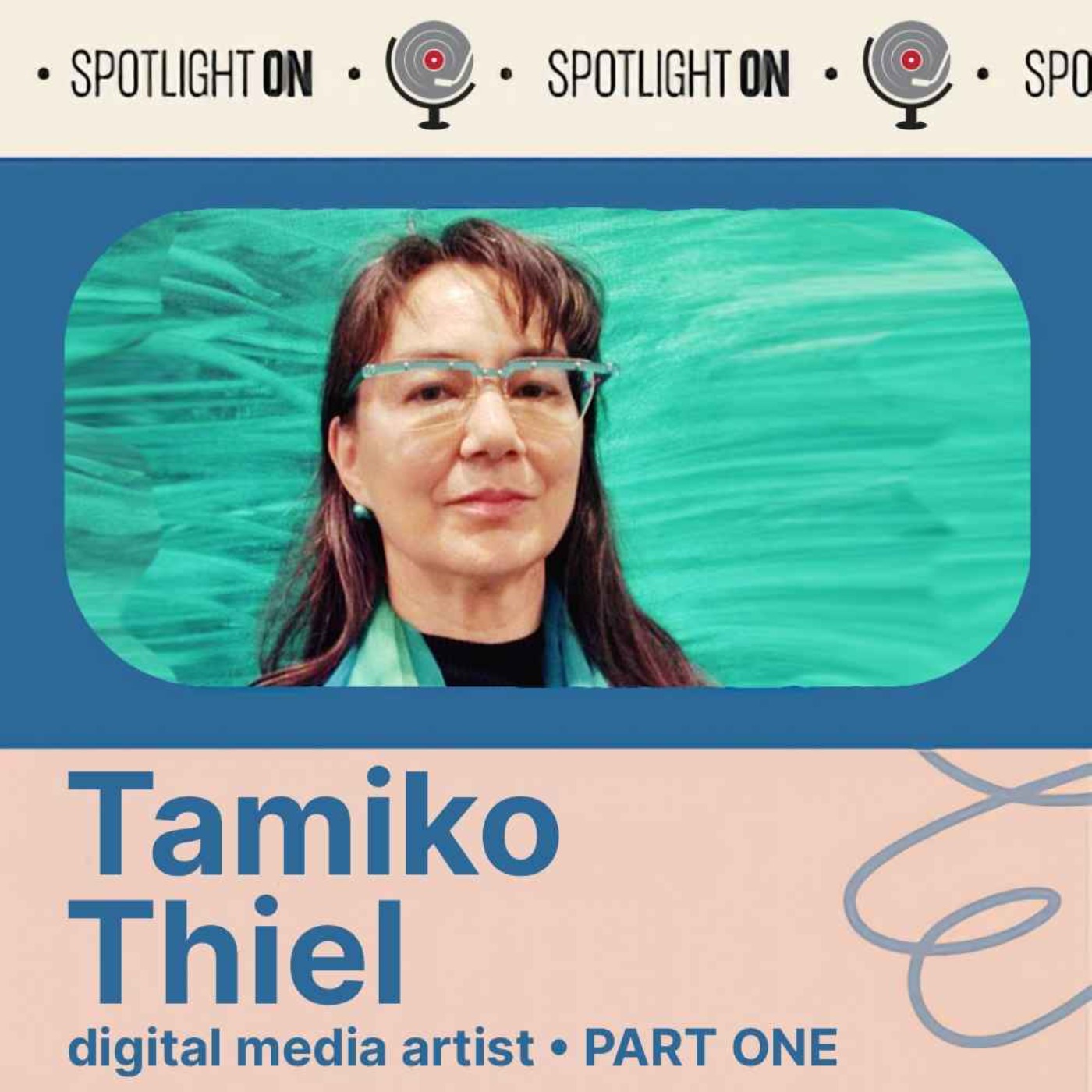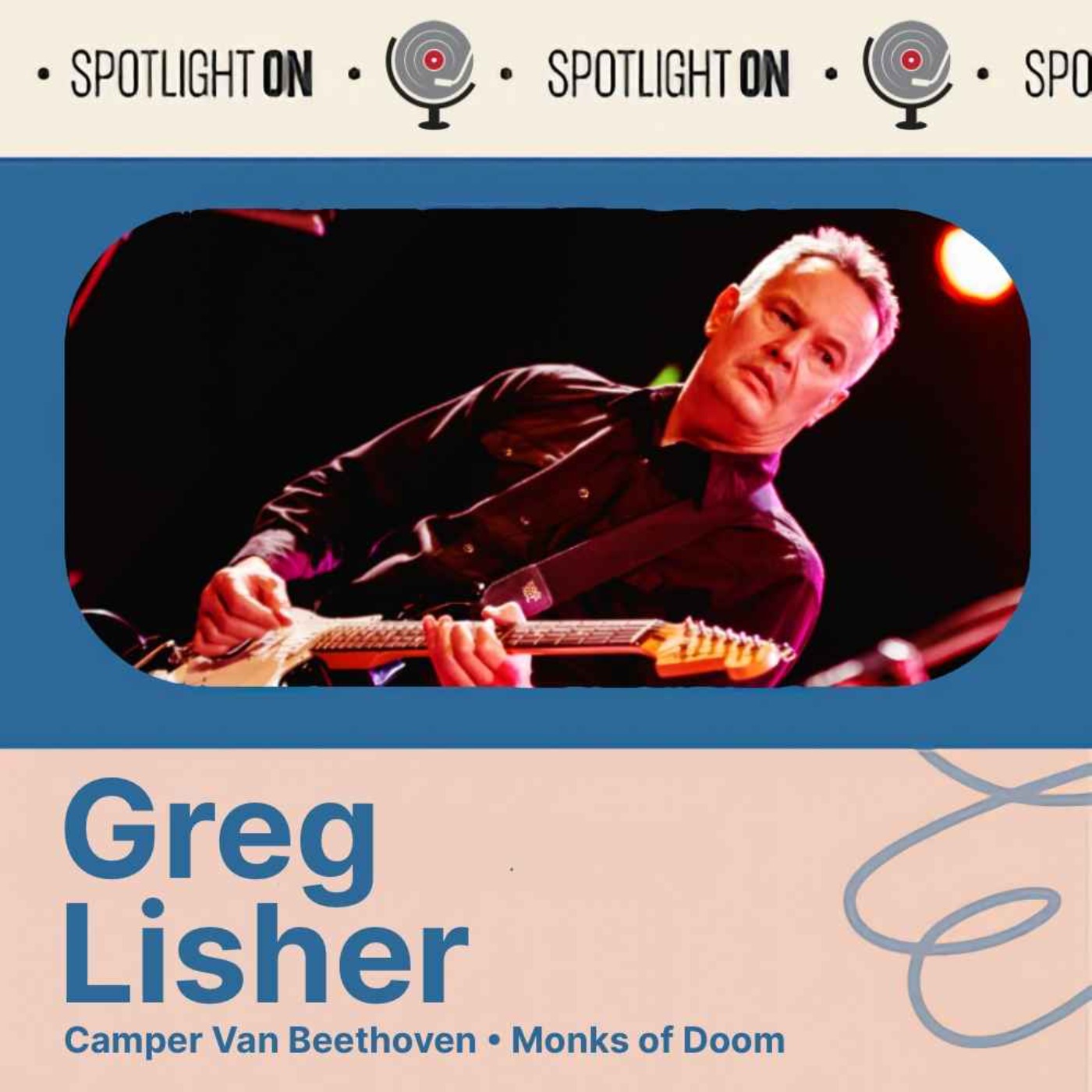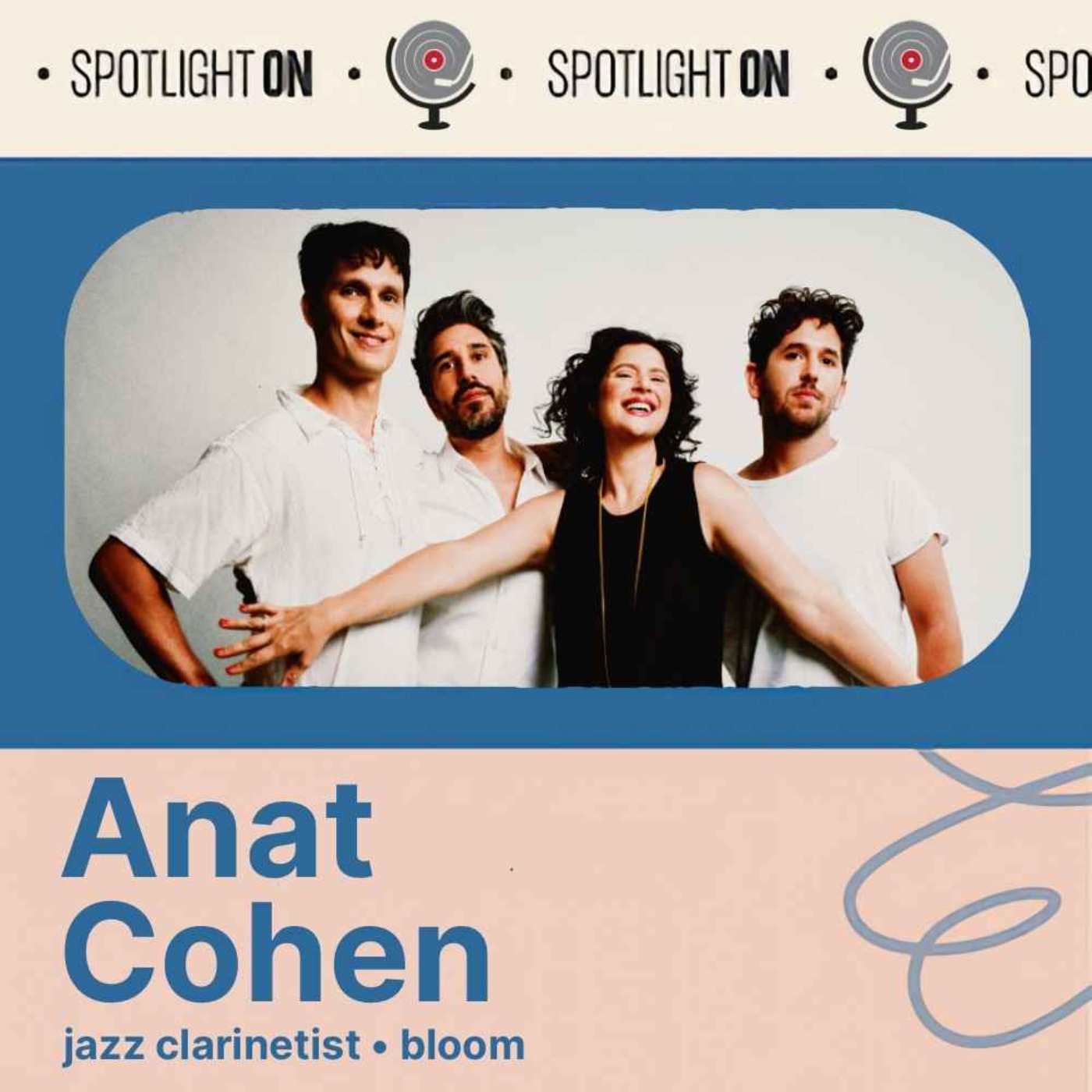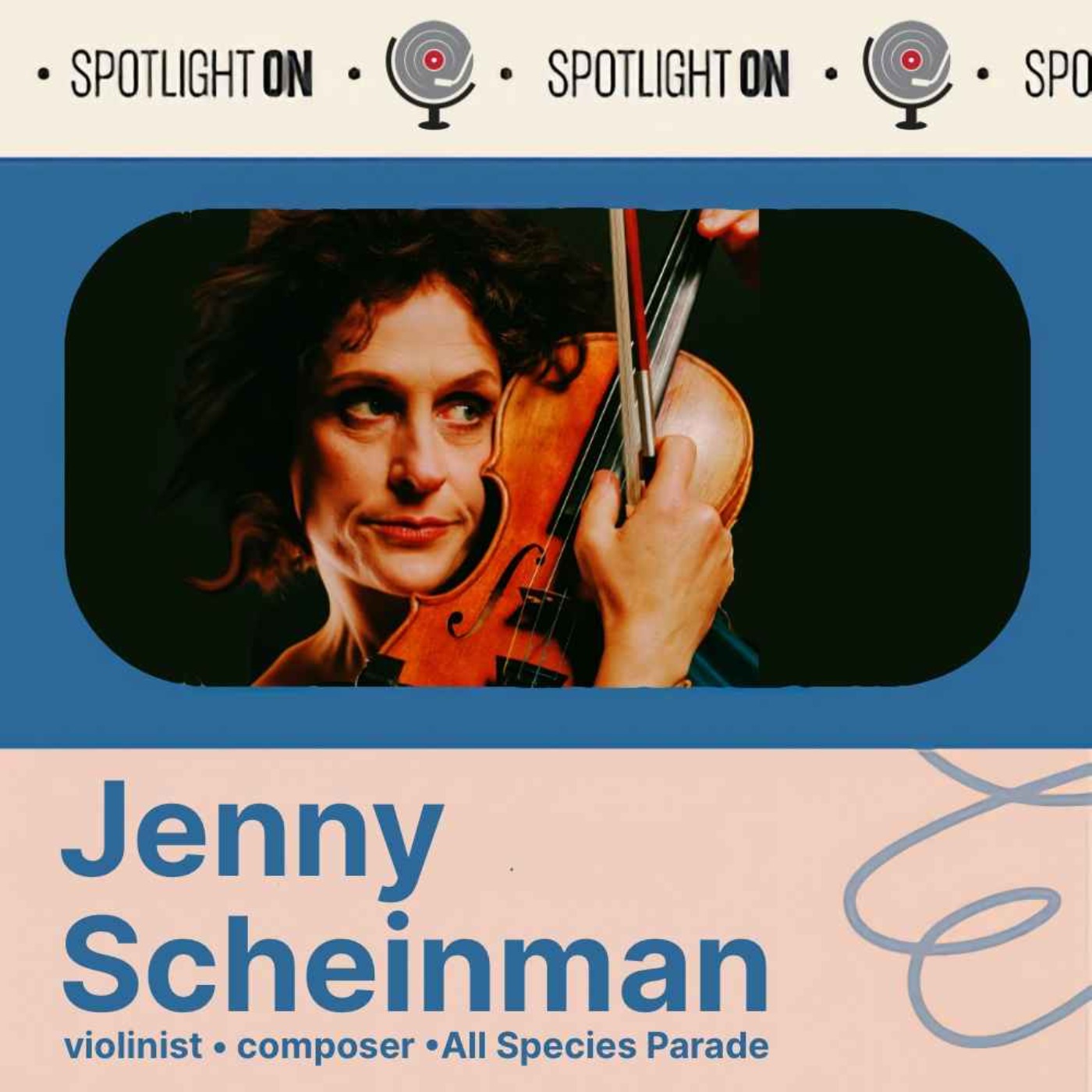Kim Perlak: Guitar, Percussion, and the Space Between
The Berklee guitar chair discusses her album 'Spaces' with percussionist Francisco Mela, how natural environments inspire her compositions, and the evolution from classical interpretation to improvisational freedom.
Today, the Spotlight shines on guitarist and composer Kim Perlak.
Kim chairs the guitar department at Berklee College of Music, where she’s spent over a decade expanding from classical performance into composition and improvisation. Her new album, Spaces, is a collaboration with percussionist Francisco Mela. The record captures four nature-inspired suites that obliterate the lines between written music and spontaneous creation.
The project shows how Kim moved from performing exclusively new classical works to embracing improvisation and collaborative music-making. Recorded live in a single afternoon at a studio overlooking New Hampshire’s Squam Lake, Spaces reveals Kim’s deep connection to the natural world and her belief in creating musical environments where artists can truly listen to each other.
Kim is here to share the story behind this unique project and discuss how creating space—both musical and personal—has shaped her approach to teaching and performing.
(The musical excerpts heard in the interview are from Kim Perlak & Francisco Mela’s album Spaces)
Dig Deeper
• Visit Kim Perlak at kimperlak.com and follow her on Instagram, Facebook, and YouTube
• Purchase Kim Perlak & Francisco Mela’s Spaces from Sacred Black Records or Qobuz and listen on your streaming platform of choice
• Francisco Mela - drummer and percussionist
• Meet Dr. Kim Perlak, Chair of Guitar at Berklee College of Music
Collaborators and Musicians:
• David Tronzo - slide guitarist and Berklee professor
• McCoy Tyner - jazz pianist
• Mick Goodrick - jazz guitarist and educator
• Joe Lovano - jazz saxophonist
• Esperanza Spalding - jazz bassist and vocalist
• Kenny Barron - jazz pianist
• John Scofield - jazz guitarist
Educational Institutions:
• Berklee College of Music
• Berklee Guitar Department
• Yale University School of Music
• University of Texas at Austin
• Stetson University
Guitar Makers and Equipment:
• D’Addario Strings - guitar strings
• Thomas Humphrey Guitars - classical guitar maker
• Steve Connor Guitars - classical guitar maker
• Fishman Aura - acoustic guitar electronics
• AER Amplifiers - acoustic amplification
Recording and Venues:
• Squam Sound Studio - Ashland, New Hampshire
• The Lilypad - Cambridge, Massachusetts
• Blue Note - New York jazz venue
• Wally’s Cafe Jazz Club - Boston
Educational Resources:
• National Guitar Workshop
• Guitar Foundation of America
• Peabody Institute Fretfest
• Classical Technique for the Modern Guitarist - Berklee Press
Natural Locations Referenced:
• Charles River - Boston
• Squam Lake - New Hampshire
• The Berkshires - Massachusetts
• On Golden Pond - classic film shot at Squam Lake
Pizza Establishments (New Haven):
• Modern Apizza
• Sally’s Apizza
• Frank Pepe Pizzeria
Support Organizations:
• Veterans Guitar Project - Austin, Texas
• Center for African American Southern Music
• The Music and Health Institute - Berklee College of Music
(This transcript has been lightly edited for clarity.)
Lawrence Peryer: Let's start with the origin story of the album Spaces. Tell me a little bit about the evolution of going from professional colleague in one context with your duo partner, Francisco Mela, and how you wound up exploring the potential of working together, and then how did that idea actually become a project?
Kim Perlak: That's a great question. So Francisco Mela is, as you know, a wonderful percussionist and versatile drummer. He's a great friend to the guitar department here at Berklee in the sense that when we have guests and when we have special events, he's kind of first on our mind as a person that we would like to work with.
We'd worked with him in a number of contexts, and then he and I really met because we did a beautiful concert a few years ago to honor Mick Goodrick's legacy. It was at the end of Mick's life, and Mick knew that. So he had a list of people he wanted to be in touch with once, one more time. We invited a number of them to campus. When we did that, we needed to have someone in the rhythm section who was just the person who could manage all of what that means for people and the music. Mela was the person that we chose. He and I spent a lot of time together because I was the MC and the director of that concert with our assistant chair, Cheryl Bailey.
I just loved the way that he made space for everyone and was able to really be there. It impressed me—his ability to be there in those moments with us at that really emotional time and make it a beautiful experience, I think, for everyone, including Mick.
Lawrence: Mm.
Kim: And then it was a while after that. We would just keep running into each other. And then I was working on this music, this solo guitar music, and one day last year—so it was a couple years after that experience—he just came in and said, "Okay, we have to play and I want to play your music. We're playing and we're doing this." I had a concert booked in the Berklee Performance Center. I was going to showcase some of my music with my duo partner, David Tronzo, slide guitar player. Some of this music was going to be solo.
When Mela and I met, I just started playing, and he said, "What should I do?" And I said, "Just do whatever you want." I think we played for just a few minutes before we kind of looked at each other and thought, "Okay, let's keep going." By the end of that first session that we did playing together, we decided to make a record. This is the record that we decided to make. It was so natural. I think for me, it just opened up all kinds of ways to think of the music and to improvise with it and to be creative with it.
I think we really had a musical connection that everybody could hear when we played that concert in the performance center. We had a wonderful time. We had a dancer join us, so it was a quartet with dancer and two guitars and percussion. David said later too, "You know, I think you and Mela really have something special. You should explore that." We just continued with it and got in the studio and then it really blossomed. I think you can hear it in the studio and the record, because it really was a live performance situation. We just did one, two, three, take a break. One, two, three. Take a break. One, two, three. Then we improvised the last three. So that's how it evolved.
Lawrence: I don't remember if I said this to you in our earlier email exchange when we first connected, but I was primarily familiar with him because for a long time I lived in New York and I would go see McCoy Tyner all the time at the Blue Note. At some point, Francisco became the drummer. I can remember explicitly some nights—two things I'll share with you about him—or even some sections of performances. He would sort of grab McCoy's attention and they would just look at each other across the bandstand and laugh. It's always so fun to see that when musicians do that to each other. McCoy is just so rhythmic anyway, but it was, so I have very fond memories of seeing him.
The other is that one night, years and years ago, my oldest son, who's twenty years old and in college now—he was probably, I don't know, he was under ten—and I took him to go see McCoy for the first time. The band were tickled to see young kids in the audience. I took him with a friend of his. After the show, Francisco came down and talked to the kids and drew a picture on a napkin of him at the drum set and gave it to the kids. It was very cute.
But something that's just been a revelation over the last few years is because I only knew him in that more, in that context—he's really started to do some exciting stuff in the last few years. So it's been really fun to watch and then to see his name on this record. It's great to be able to witness a musician's evolution that way. It's fun.
Kim: I think so. I mean, this was also an evolution for me. When I came to Berklee, I had been playing predominantly American music by living composers. I was already there and then working occasionally when I could at festivals and things, playing with people outside of classical music. But when I came here was when I first really started to improvise and compose and kind of live in that world where modern classical music and modern improvised music meet.
I had played for a number of years with David Tronzo, and then Mela really is the first person to come to me and say, "Oh, I want to play, I want to improvise with you. I want to play new music with you in my new style." So it really helped me grow to have that moment in my own trajectory. It's interesting how that works—we're all on our own paths and then sometimes your growth meets someone else's in a certain way.
Lawrence: You know, a theme that comes up a lot in my discussions with artists here and even with other sort of music listening friends and colleagues, is this exciting moment over the last, let's call it a decade or so, just to fence it in some way. It could be a little less or a little more, but this coming together of modern classical and improvisational music, and artists from different traditions coming together, or artists evolving their tradition in the way you described, that you've been doing since 2013-ish, since you arrived at Berklee, basically.
I'm really curious about negotiating that. Coming from—another thing that comes up a lot is artists that were trained in the classical tradition, especially those of a certain generation when they were in conservatory or taking lessons. A lot of people were discouraged from improvising, or told certain musics were not places they shouldn't go. Curious if you could talk about how some of those notions or themes—do you relate to that at all, or how did you navigate those transitions, and then how did you wind up in a place where you were doing the type of work you're doing? Because I would imagine—I can't speak to how lucrative a career it is in interpreting the classical repertoire, but it's certainly, there's certainly a well there to be explored. It's not intuitive that you would step away from that.
Kim: I think that there's a lot there in what you said, in every aspect. I think what strikes me the most is that in the instances where I feel like I am branching out from where I started, it's more like I met a person who I felt like I connected with about what music is and what music does. I think there's two aspects. There's what it is to you and what it does. In the case of both of my duos, and I think really what you hear in this record with Mela, is that we were aligned on both ways. Music is powerful in our lives beyond what the style or the genre or the notes are, in a similar way, I think that we identify with right away without almost talking about it.
And then in terms of what it is, in terms of how it could work together, inside or outside of a genre, it's less bounded for us. It's more about sound and texture and form and the bigger questions as opposed to a stylistic boundary that would keep something out. It also didn't feel like we had to layer, "Okay, you're in a style and I'm in a style and we're going to do them at the same time." It was more like, "I have this and you have this other thing, and how do we work together? How do we play together?" So I think the value system matched even if musically the thing seemed very different.
I think that's the first thing that has to happen because we all come with our background and our training and our perceptions and what we care about and what we value, what we love. If some of those fundamental values are the same and shared, then there's a lot of room to play. Or conversely, if you play the same style and you have the same repertoire and you have the same chops, then that's also easy because you could just say, "Call a tune," or say, you know, if you're a classical musician and you play strings, you could say, "Oh, we're going to play this string quartet by Mozart." Everybody knows the part and the other stuff may or may not come together. But you know, the music or the way that people say, "Oh, we're going to play the blues in F or we're going to play 'All the Things You Are.'" If you know those forms or that tune, then you're good.
And in this music, it's more about the "what music does" that becomes the driver and then you can put whatever other stuff in there, you could try different things and see what works. And so I think that's where, from what I understand of my friends who are modern improvisers, that's where it's a lot the same as modern classical music in a way.
Because in modern classical music, you come with textures and an idea of form and a tone and phrasing and a gestural approach to things. You have all this repertoire that informs your instincts. When you come to modern improvisation, you have a whole other set of techniques and approaches and your chops and all your things that come from playing. Maybe a variety of different jazz styles or popular styles or both. Then there's likely going to be a way to build something together. You're kind of building an aggregate form. So in that way, I think there's a lot of similarity. What we're drawing on is different.
So I think to the extent that it's okay if we have different vocabulary—with Mela, because he is a percussionist, we're more talking about rhythmic structures. But if it—sometimes when it comes out of, if a person also plays a harmonic or melodic instrument, like are you okay with understanding that someone might call this an Aeolian mode where someone else may call it an extended harmony, like a B-flat seven with a flat nine or something. Can you change your language? Is that okay? Does that work for you? I think that sometimes there's a barrier there when you're working across styles where it's just sometimes hard for people to not have the real foundation of the vocabulary that they're used to and the sounds that they're used to and the forms that they're used to. Whether that comes from classical music, which it certainly does because a lot of us don't come up in improvisation.
And so that was the other part I think of what you said that struck me, was that I had played folk guitar and steel string guitar, like fingerstyle guitar for a while when I was a kid, and then switched over to classical music. I'd always been around—because I'd often be the only classical guitarist at a guitar festival with multiple styles—I'd been around people, but I didn't have that vocabulary to play changes and to understand even what that really was.
When I came to Berklee and I really wanted to improvise and I just had this feeling like I really wanted to be able to sit down and create music, I had a number of different lessons just going to people's offices as I got to know people and saying, "Oh, this is really great what you do. Could you show me a little bit about what you're doing?" When I got to David Tronzo, he said, "Well, instead of starting over as though you know nothing, why don't we just leverage every instinct that you have and just—everyone who improvises has their own approach and their own sound. Let's just see where your instincts lead you. So instead of saying to yourself, 'I don't know what to play,' just play, then let's see." (laughter)
Lawrence: Imagine that!
Kim: Right! So let's play. When you say that to a classical musician, sometimes we're like, "What are you talking about, you know, just play?" Then you realize there's so many things. I love my playing when I sound like this, or this is something that I think kind of defines my sound. If you heard me on the radio back then, or on a record or something, you'd say, "Oh, that sounds like Kim." What are those things? They were connected to repertoire for me, but they would be like lyrical melodies and counterpoint and texture and different things with color and tone. Could you take that out of context? What if you just wrote your own material? But it's those things.
For me it was a big process of being able to take things out of context and put them in my own context. Because so much of what I did was repertoire based for many, many years. I think honestly, that's kind of true of a lot of styles, not just classical music. It's just very obvious in classical music.
Lawrence: How familiar were you and either of your duo partners? How familiar were you with each other's canons?
Kim: You mean what we learned from, or what we produced?
Lawrence: Oh, that's a great distinction. Thank you. What you learned from.
Kim: I should have said traditions, I suppose.
Kim: No, I think that's great. I have a unique experience in that I had this amazing guitar teacher when I was in high school. I had had these wonderful fingerstyle teachers in middle school age and one of them was the brother of Arlo Guthrie's main guitar player. The other one was also in his band, Arlo Guthrie's band. They were just incredible folk musicians and they were kind of staples in our area. Everybody knew them.
When they kind of moved on from doing that, probably now that I look back, I mean, clearly they were going on tour, but I didn't know what that was. I was twelve or thirteen. So I ended up with this woman, Suzanne Higgins, and she was a great classical player, but she played a lot of different styles. She also did therapy like massage therapy and hand therapy for musicians. One of her massage clients was Paul Wertico from Pat Metheny's band. She had a relationship with that group where whenever they played nearby, she could bring a bunch of students. So she would bring me as a kid and I would go and just kind of soak up all that music and then we would hang out afterwards. She just started doing that all the time.
So when I was a child studying the guitar and getting into classical music, I was also right up front or backstage with anyone you can imagine, from [John] Patitucci to Mick Goodrick to John Scofield, and Joe Henderson and Joshua Redman. I had met Mark Whitfield and all these people who now I know peripherally or through my position at Berklee—I was a kid on the side with the little wristband on, listening to all this great music in person and really, she was so great at just teaching me how to say thank you and just say something nice after the show. So I heard a lot of jazz.
Lawrence: Did you like any of it?
Kim: I loved it.
Lawrence: Okay.
Kim: But I really loved what I was doing on the guitar too, so it didn't feel like, it didn't feel like, "Oh, you should be doing this or this is cooler." I just absorbed all of it as a listener and I just really loved it. So I had that relationship to that music. David also played in a lot of pop acts and I had a lot of records. He played with—he did some work with Paul Simon and a number of other people and then some stuff in classical music like with Philip Glass and stuff like that. That's all music that I had studied, so I had that shared background, at least as a listener.
With Mela, in addition, I worked at this wonderful festival for a number of years called the National Guitar Workshop, and I came up through there as a student, and then I was a staff member. Then I taught there for a long time from, I think it was 1999 to 2012, I taught there. I taught there all summer. So everybody came through, and one of our colleagues there was Aaron Scott who played with McCoy Tyner as well. So I knew that music, I knew that group, I knew that.
Then as I came to Berklee, I just felt like as the chair and really as a steward of the guitar department, I would just kind of absorb myself in all of our alumni. So if I wasn't already familiar with some of them, which I was, I got really into their music. So I had already been into Lage Lund and Mike Stern and all of John McLaughlin's music obviously because he plays nylon-string guitar and all of that stuff.
So yeah, I had a pretty eclectic listening background and so did both of my duo partners. They both have a really extensive modern classical listening background. I think with guitar, with David, because he did prepared guitar coming from that modern improvised context, he did some work in modern classical music, especially in Europe, because there is more of a blend, I think, in certain places. So he already had—I think that was kind of what also made it work was they could see it could work. Even though, especially with Mela, I think you initially see a drum set and a classical guitar and you think, "How is that going to work?" But he didn't think that, and I knew because his playing was so colorful, I knew that he would approach it in this really rhythmic, but also textural and colorful way that wouldn't just take away all of the sustain of the guitar.
Lawrence: That's one of the most striking elements of the collaboration—the color is probably the best word. There's a real sensitivity in it that, again, as somebody who was more familiar with his background in a different context, it was really eye-opening. Really eye-opening.
Kim: That's great. That's so great to hear.
Lawrence: Tell me a little bit about—I think about maybe second only to the piano, I think of a classical guitarist as somebody who would be completely capable, both from a repertoire point of view and maybe from a temperament point of view of being able to perform solo for a career. I'm curious, you've referenced whether you're duos or other contexts, like collaboration seems to be thematically strong here. I'm curious about your orientation as a collaborator versus as a solo interpreter or performer.
Kim: I really love both things. I think they feed each other because sometimes if I'm writing something and I have an intention that it's going to be for multiple people, I also feel like it's stronger if I can pull it off as a soloist. Because then the ideas, I think, get really clear. Especially, if I know, "Okay, there I need to leave room for other people." Well, what would it be like if that person wasn't there?
Lawrence: Oh, interesting.
Kim: What does that mean and how does that clarify? Or if it's something I can't do on my own—a sound that can only come from another instrument, basically. What does that mean and how does that clarify? Or if I just, like with Mela a lot of the time, I have a good sense of all the colors he has, but I also want to be surprised. Those moments that you referenced of watching him play and having someone turn to him and smile—he probably did something super cool and inventive in that moment that you can't plan for. So that could be great.
There's part of my personality, I think that's very introverted and I love the idea that I can sit with a guitar and play alone. Now I love the idea that I'm working with improvisation that I can spontaneously compose. I love that. I love the relationship part of playing with people. I've never been really a person who does a lot of gigs in the sense of like, "Come and we'll play this one gig and then we'll go home," and that's kind of it, where the repertoire is the connector.
I've been in more sort of long-term musical relationships where the relationship is the connector and the value system is the connector and the creative process is the connector. I think that was true even with the classical groups I was in that lasted a long time, or a significant period of time. I think we kind of came together because we felt like we gel as musicians and as people. So now what we play is going to have this real sense of spontaneity, but also clarity and depth, but also sort of a freedom. I think in the music that I've always been drawn to, that's true. Those elements are there more than just in a moment, which is also beautiful. But I think for me it was more like you have these beautiful moments that also become these long-term musical relationships, and so you hear something in the music itself that I think reflects that, for me.
Lawrence: It's really intriguing to hear you return to this idea of values-based or values sharing. Something that feels maybe adjacent to that—and you could disavow me of this if it's the wrong connection to be making—is the way the natural world is an inspiration at least for this set of compositions and improvisations. The leap I would make there is finding the value in the natural world as an inspiration, as a sort of spiritual collaborator or if you'll stay in that philosophical zone with me for a moment, but I'm curious a little bit more practically about how you translate physical environment into the music. Like do you—is this an ephemeral vibe? Is it how you think about harmony, rhythm? It seems to transcend song titles. It's more than just song titles, and I'm curious what you could say about that.
Kim: I think the other component for me is that I'm a visual artist as well.
Lawrence: Oh, okay. That makes sense.
Kim: So I've always kind of been interested in what a color might sound like. Or what something might sound like. I think as a person who came to composition much later than performance, it's super helpful because instead of thinking, "Okay, what do I want to hear? What do I want to hear?" I'm trying to put it into music instead of going back necessarily and finding other music and saying, "Is it like this or not like this?" Then it's more that I'm looking at something like, for example, in "Lake," there's this beautiful thing that happens in August where the clouds sit on the water and it's all misty. And then as the sun comes out, the mist comes up. So it's like, "Okay. What does that sound like? What would that sound like? What kind of harmony would it be? And then what would you have to do with your hands to get it to work?"
So that idea of kind of stacking intervals, unconventionally, and then brushing the strings really fast in what they call rasgueado in classical music. That sound to me is like—and the speed at which you do it and the pitch level at which you do it, the register—that to me sounded like what I was looking at.
Similarly, there's these moments. I would take these little videos when something was beautiful, like of light dancing as the wind picks up. What would that sound like? And so then I would try different things and then you think, "Okay, and is there kind of a rhythm behind it? Is there what—and it kind of is, it's kind of timed. It's not really timed, but it feels like it, if you look at it long enough, you're like, "Oh, there is," and then there's these white cranes that live out there where I was. The way they would swoop through super elegantly. Well, that's like another theme. What would that sound like?
So I'm kind of constantly asking myself that. What would this sound like? Then you try something and then it kind of takes on a life of its own. And then past that I would think, "Okay, what are structures I could use?" And then that's where some stylistic influences came in, in terms of how are you going to create the form past these ideas, that type of thing.
Lawrence: Tell me a little bit about then physical environment. In terms of where you compose, do you sit in—I don't, I'm not really familiar with what some of the facilities might be like where you are, but do you go to a room, is there a compositional studio there, or do you, when you're in a recording studio, it seems like you would be highly attuned or sensitive to your surroundings based on the way you're talking. I'm curious, do you have an intellectualization of that? Are you aware of that? Do you know you're sensitive to it or am I completely wrong?
Kim: No, you're totally right. I think for me, what I'm trying to do is have different places. So this office is pretty good because I've got a window that looks out to a wetland system. I can open the window and I also have a nice room at my house and then there's a lake cottage that our family has that's seasonal. So I did a lot of writing out there when I could be out there.
The thing is, I have these little notebooks. I have a lot of little notebooks that are small that are staff paper and stuff like that. The other thing that really helps me is I just have the phone, and so if I'm taking a walk or if there's something that's happening in front of me, I take little videos and photos of things. That way it doesn't really matter where I am, as long as I'm somewhere quiet. I have the reference and I'm like, "Oh, what is that?" And then I'll also take a lot of walks and see what comes.
So I have notebooks with a lot of ideas. Sometimes I write without the guitar, just freewrite and see what happens. Sometimes I'll be on the guitar. But I felt like the, that kind of idea of automatic writing where you just write notes and things that kind of look artistic and then just sight read what you write.
Lawrence: Oh, you have sort of the reference work.
Kim: Yeah.
Lawrence: Yeah.
Kim: And then just see, because there have been so many little things over the years now where I think, "Oh, that's really beautiful. I wonder what that will be." And then it ends up in a piece like, "Oh, that makes sense. That's going to be that," and if you hear some of the recordings I did, especially the improvised ones, with David Tronzo, you'll hear it like, "Oh, that type of harmony that ended up in 'Lake,'" years later that's a chord that I kind of, "Oh, that's beautiful, I'm wondering, you know, like—and maybe we found that improvising something and it worked great there, and then later it could have a different life in a different way. It's treated totally differently, but the younger version of it was over here. So I think that idea that ideas could have a different life in a different piece, that's also a cool idea to me.
Lawrence: I have to ask you sort of a guitarist specific question or two and the first one is, are you much of a gearhead?
Kim: Number one in classical guitar? Our gear is like the actual guitar, to a certain extent. For me, I bought my very first nice classical guitar I got from Beverly Maher, who's still down in the guitar salon in New York City on Grove Street. I was fifteen and I got this flamenco guitar and it's beautiful and I still have it.
In college I met Tom Humphrey, who was one of the great American guitar makers, and he liked my playing and I bought a guitar that was his, and then he built me one. So that was what I played for a long time. And then this year I got a new guitar, Steve Connor, who is in Cape Cod here, he is really now I think one of the prominent American makers. He built me a guitar for this music. So when I play it solo coming up, I'll have that concert guitar.
Then the guitar that I play on the record is an electric nylon guitar that Kirk Sand built and Kirk passed away just a year ago. He was well known, built for the Nashville nylon pickers, and they all recommended him to me when I first came to Berklee. Because I needed a great guitar that sounded absolutely beautiful, and I could play it in a black box theater or a theater or a hall or a venue that was really built for electric guitars. It has resonance to it. It's a thin line, so it's two and a half inches and then it has a Barbera pickup system.
Then I talked to my friends at Fishman and I used the Aura pedal that they have, but I went to their studio and recorded my own sound so it mixes in with the amplifier sound that it's its own beautiful thing. I think—I mean, this record was made on that guitar, and I just think it's gorgeous. It plays great. It's just an amazing sound. The other thing was amps, trying the different amps and the AER amp gave me a little—it almost has this kind of real world roomy sound. When you mix that with the microphones that we imaged with the Aura, which are Neumann microphones—
Lawrence: So it's got some resonance to it, or—
Kim: Yeah. And then D'Addario makes these amazing strings. I've been a D'Addario artist for a long time now, and their new nylon strings, the XS, they're just unbelievable. They're glossy and they're a little thinner than the other ones, and they just, everything just kind of flies, and sounds really, it has that kind of bright without being edgy, but the depth that you kind of expect from D'Addario. So it's like—
Lawrence: Yeah, it's a great sound.
Kim: That stuff is great. And then on top of that, my friends have this amazing guitar support. So instead of using a footstool, it's called Le Support and they're in Paris and it's like the most comfortable, solid guitar support ever. Suction cups, and it just pulls the guitar up and it changed everything for me. I know it sounds a little crazy because you've got all of this gear, but when you can get the guitar in the right spot, especially when you're improvising, you just go, now, you just flow. I feel like I can sit up straight and everything just flows. So—
Lawrence: No distraction from the body sort of—
Kim: No, not at all. And it doesn't feel wobbly. It's going to stay put, no matter what. You could be as active and mobile as you want, and that guitar's going to be in the right spot. So it lets you, I think when you're improvising, that was a big transition for me. When you're interpreting music, you can be spontaneous, but you have it in a context like you know what's coming. When you're spontaneously composing, there are moments where you really don't know what's coming. So everything has to feel as secure as possible, or you're going to be limited as a classical musician with how complex you can be.
That's still kind of a struggle for me. There are things I try where I think I sound pretty good at, but it's not the level of complexity that I would expect from my playing. Sometimes that's okay. Sometimes simple is complex and deep and beautiful. It's a negotiation because it's just a different mindset and a different physical reality. Finding that balance I find really interesting and it's exciting. So that's how I got kind of become a gearhead—how to support the thing.
I also worked in a great recording studio for three years full-time—halftime for two of them, and full-time for one—at Sprague Hall Fred Plaut Studios at Yale University. That's why I know my Neumann microphones, that's—
Lawrence: You lived in New Haven for a while, or did you study at Yale?
Kim: I went to Yale. I went to Yale School of Music for my master's degree and I stayed an additional year. I worked in the recording studio and it was right before I went and did a doctorate in performance. That was just such an incredibly eye-opening experience in terms of all the things we're thinking about. Like, I think it really made me realize that every time you're practicing and every time you're rehearsing, and certainly every time you're playing, you're producing yourself. Even when you're writing and arranging, I mean, all composition really becomes arranging to a certain extent. That's really production because you're asking yourself, "What does this need and what does it have too much or too little of? Or what is it, what do I want it to do?"
Lawrence: I'm from Hamden originally.
Kim: Are you really? Oh, that's so cool. We used to go up there. There used to be really good sushi in Hamden, and we'd drive out there. That's so great. That's really cool.
Lawrence: Well, before I move on, should we spend a minute in the great pizza debate? Are you a New Haven pizza person?
Kim: Yeah, I lived near Modern.
Lawrence: Me too. I lived on State Street. I used to have a bookstore down there, years ago.
Kim: Oh, no way. Okay. So I lived, when I first moved to New Haven, I lived on Bradley and Orange. There's a really beautiful house with a little tower on it and a fire escape. I lived in there, and then I lived on Pearl Street, but on the State Street side.
Lawrence: I lived right on State between Bishop and Edwards.
Kim: Oh, yeah. I lived near the little Polish deli, just a couple brownstones down from there.
Lawrence: Oh.
Kim: You had the Polish on that side and then all the Italian as you came down the street.
Lawrence: I was just back home about a month or so ago, and people who listen to this podcast are sick of me talking about it, but I'm a New Haven partisan. I feel like that city hits above its weight for its city size. I love New Haven.
Kim: It's good. I love going back there too. I miss a few things. Like I loved DeRose's. It was right across the street from me for a while, and I love the family. They were great.
Lawrence: So you do know what you're talking about. (laughter)
Kim: Yep. I know what I'm doing.
Lawrence: DeRose's! By the way, the fact that you called out Modern, that's special to me because everybody says, "Oh, are you Sally's or Pepe's?" And I say, I am Modern. Like, I am Modern.
Kim: We did a blind test before we all moved away, and I picked Modern in the blind test. So I feel like it's real. The sauce is different. Their sauce is sweeter.
Lawrence: It's the Modern with eggplant. It just kills me. It brings tears to my eyes. (laughter)
Kim: See, this is so good. Yeah.
Lawrence: All right. Let me get off this topic before I get hungry. A couple other nerdy questions before I get back to the art. How often do you change your strings? I'm so curious about that. Do you wait till they break or are you proactive?
Kim: Ooh, no, I'm proactive because I use ping pong balls for fingernails, which is like an oral tradition in classical music. So basically what you do is you, if you haven't seen it before, you grow out your real nail enough so that you can cut a little square of a ping pong ball and then cut a half moon and glue it, super glue it in there.
Lawrence: Incredible.
Kim: And so they're great. They don't break, they don't fall off. I use the Nittaku 3-Star Premium ping pong ball, which is the best ping pong ball. That's another gear thing. It's the Olympic ping pong ball, which means that you get—it's really not very porous. It's very thick plastic, but it's completely even in thickness, which it has to be obviously for the Olympics, for the balance of the ball and whatnot. So that means that you get a consistent tone.
That is why I have to change my strings fairly frequently because the strings, I mean it's plastic on plastic, or plastic on nylon. So you could tell like, if I just kind of run my fingers on the trebles, I'll know if it's a little scratchy.
Lawrence: Yeah. Brutal.
Kim: I'm super picky about my tone. I want it really, really clear and fat and warm and lyrical and I can hear just a little edge. So, and then the basses will just not be—then they won't have the brightness of the register if you let them go too dead.
Lawrence: Start to thin out. Yeah.
Lawrence: That's interesting. So, all right, one last one on this theme, and I promise I'll move on. Have you played with amp emulators at all? And do you have a position on that?
Kim: No, I haven't done that.
Lawrence: They seem very polarizing. People that are into them are pretty strident. Like people are into them or not into them. It's interesting.
Kim: You know, it's interesting. I feel like I'm very fortunate because when I play my concert, classical guitar, my traditional guitar, I have the best guitar maker I think, and I have incredibly great strings from D'Addario. That sound is, that's my sound. Whether I'm playing the Connor or the Humphrey, I feel like they're two different aspects of my sound. I feel like it really sounds like me. That's what I love the most about the Connor is I feel like it's kind of the new me in a way.
Lawrence: Mm.
Kim: And then when I play the Kirk Sand guitar and I have that Fishman Aura box, I feel like that really is the sound of that guitar. So when it comes to amplification, like there is an element there, but I have this freedom because I have this thing that I go around with. Like I already have this aspect of my sound that's going to be consistent to me, which I think is important in a certain way. So that's kind of how I think about the tone part.
Lawrence: I love hearing guitarists talk about where their tone lives. Because it's so fascinating how you can give a guitarist almost any ax, and you can hear the guitarist. It's so fascinating.
Kim: Well, that's the other thing I was just about to say. I just said that about my sound, which I believe, and I think that your tone lives in your hands. How—I mean, your sound lives in your hands. Your sound maybe is more than your tone. So you can bring it out on a lot of different things, which I do think is true. Sometimes you have to. So I think it's good to have a plan for that.
Lawrence: So fascinating. Tell me about the spiritual dimension to your music, whether it's this album in particular or more generally, because you've—some of the quotes in the press material around the album talked about sort of presence, being in the moment, things of that nature. I'm curious if you could talk about that a little bit.
Kim: I think that's always been a part of my guitar playing because when I went to the guitar, even when I was a kid, I came from piano. I think one of the things I realized about the piano pretty early on was everyone can hear you practice the piano in your house. Sometimes outside your house, but the guitar, that's not true. Especially if you have an acoustic guitar or a classical guitar, you can go sit wherever you want and it can be a more intimate personal experience. I was very drawn to that the whole time I've played that aspect of having it be a spiritual connection beyond me and sort of to something bigger than myself, has definitely been part of my relationship with music and particularly the guitar. So that's absolutely true.
I think there is a meditative experience that happens for me when I play and when I'm writing. That's absolutely true and I think that's part of the idea of the natural world being such a big inspiration is I think there's a connection there for me with that as well.
That's very true. I do feel this idea about being in the moment and being present and being present with yourself and with other people is something that more and more it's harder to do. We're in a very distracted world and a lot of the students I teach have grown up in a distracted world in a very tech-heavy world. I think it's very good to have something solid in your life where you're connected to an instrument, you're connected to something you're doing with your hands. Like producing sound with your hands can be very grounding. So then the world around you can be crazy. And then there's a moment where you don't have to. That's really important to me. I think it's an important example to set and I think it's an important grounding thing.
I think when, if I can get into that mindset for myself and then I can have a friend who gets into that mindset—in my case, for himself—then that connection also becomes part of that meditative experience. It doesn't feel like I'm competing or I'm worried about what he's going to think of what I'm playing or what other people are going to think of it. We're just communicating and we're creating something together, building something. That's important for me to have in my life just as a solo person. I think it's also a beautiful thing to have with someone else.
I think it's hard for students. It's hard for all of us because if you're trying to have that type of experience that's positive and generative, you're afraid it'll be judged or you'll be afraid that you'll be judged or all the things that you're worried about in your life can come into that and being able to sort of just keep that aside for a moment and have a connection with yourself is not easy to do. You also have to keep asking yourself as you're practicing like that, "Who am I and what do I sound like?"
I've found more and more teaching this kind of material and teaching this way. Everyone wants to have a voice and everyone wants to have a sound. Then often I'll ask a younger musician, "Describe your sound to me. Describe your tone. Describe how you sound." And they don't want to, they say, "Well, I'm not ready yet, or I don't really"—they're already judging it or they're afraid it's not good enough. When you think about it, if you can't find a way to just let yourself really think about who you are and what you sound like, it's going to be a lot harder to develop that.
So like, why not? Even when I teach adult beginners, they're just starting on the instruments, so they just begin. The hardest thing to do isn't to get them to make a list of the things they don't think are working. The hardest thing to do is to get them to make a list of what is good in their playing. We're trying to get rid of good and bad and put familiar and unfamiliar or what you want to hear and what you want to hear more of. But we live in a lot of judgment and distraction. I think in our times, since I've been teaching and definitely in my career, I think that's just been a growing reality. Maybe that's just a perception. Maybe every generation, we all think it gets worse or whatever. But I think it's a truth that we do live in a distracted time and a time where judgment sometimes is rewarded.
If you go into the world of social media or where a lot of our younger musicians especially have to live—can you find a way to be present in your music and your composition and your writing and your playing with others, at least at a core, even if you do have to branch out and do other things where you feel more exposed, but you have a center so that you can come back to it, I think is important.
Lawrence: It's striking to me how difficult it must be for a young person, especially a developing artist in any field who is engaged at all in social platforms to not have that ability, like to be expected to be fully formed and some of the grief that people get for not being already fully formed. If you want to try to put yourself out there and be vulnerable and share your work in progress, you have to be pretty thick skinned these days.
Kim: I think knowing too, that a lot of the negativity isn't about you. If it's coming to you, it's about the person who's saying the things and whatever that means for them. You hopefully can get to a point where you wish them the best. As long as you're safe, you just keep doing what you're doing. Because I don't think anyone escapes from that part of our culture now. It just becomes like, well, who are we going to be? It's just like, who are we going to be in that moment? And then who are we going to be moving forward?
I just want to think that if you put positive things forth and you build your personal connections and relationships, that ultimately over time, that grows. That's like, what is real and what is not real? What is a tool to help you make some connections? And then what is your real musical life? I think those are big questions now in a way that weren't before.
Lawrence: My last two questions have to do with your role as an educator. What do you hope—what's the governing philosophy or the thing you're hoping to teach your students? Not the practical thing of harmony or theory or what have you, but what are you trying to impart to them? That would be question one, and question two is what are you learning from your students?
Kim: I am really the steward of the largest and most stylistically diverse guitar program in academia, and I think the two things that are important from my perspective for young people is go deep on your instrument. If you want to be free, go deep. You really have to go deep to be free. You have to know the fretboard as best you can. You have to really know all the stuff that makes up music. You have to have a good sense of where you want to go with it. What do you want to do with it? Because I think there is room for everyone.
The more you know, the more free you will be to really be yourself. We're not trying to—and I'm not trying to have people sound like me. I really don't want that. I want them to take some chances and sound like themselves, and I want them to really know, really don't be afraid to learn. Don't be afraid to learn the things you don't know yet and get into every bit of it. Just dive in, like learn everything there is to know about the fretboard. Learn everything there is to know about the techniques that help you produce the sound you want to hear. Go into every stylistic authenticity that helps you speak that musical language.
As you're doing all that work, really think in your mind who your favorite guitar player is, and if that name is not your own name, change it right now. Make your favorite guitar player you, because it helps you answer all the questions and do all the work. From everything I just said, if your favorite guitar player is you, you would want that person to have the most sound, the biggest foundation of knowledge and all of the resources and all of the support. You might stop talking to yourself in a negative way and you might motivate yourself to really do the work you need to do to get where you want to go.
You might start to see other musicians as collaborators or people you can learn from and just keep it in your forefront that you're building yourself. As you hear players that you like, instead of chasing after them or competing with them, just think what is it about what they do that you love? Try to recreate that for yourself in your own way. Maybe you could make a friend by calling that person or writing to them and saying, "Oh, I love this thing that you do. Would you show me?" I can't tell you how my music has developed over time because I did that.
Don't be afraid, like maybe you'll try something and people will hate it or make fun of it, but who cares? Most of the time that's not true. We live in a world where you think that's going to happen all the time. I would just say have that courage to keep working on who you want to be and then also measure that with responsibility for the time and the energy that you're going to spend to make it happen. I think that's what I would say over time that I'd like to see for people.
Also be open to the idea that your path might not be exactly the same when you're thirty as when you were twenty, or when you're forty. Your life is going to go in different directions and they're all valuable. I see sometimes people think they had this idea of what they wanted to be when they were twenty and then their life took a different turn and they feel like maybe that's a consolation prize or wasn't as valuable to the whole, and that's not true. I think that there are a lot of components of people's musical lives, and then there's a lot to be proud of and a lot to invest in and learn from situations that maybe weren't your ideal. It doesn't mean that you've been derailed. It might mean you're learning something different that you may need on your path, so I would say those things to young people.
The students here are so inventive and totally courageous and really open, and yet very realistic about the world. I have a student who plays electric guitar with banjo picks, and then he'll play the banjo with these guitar voicings that we're doing. I have people who are really getting to know, they're overcoming just tremendous challenges in the world. Like from where they come from, where they live, they're moving here, they're finding a way to make a living, they're finding a way to do their music and just their creativity on every aspect, on the instrument and in the world, I think is really inspiring.
I've thought about it a lot. I think a lot about the way I teach things. How are they going to use them? I also learn a lot about that, some of the themes that we've talked about today, like this idea of having a musical value system and finding out what that is. Having a way of looking at things, whether they're just fundamentals of how you play and how you approach the instrument, but also how you approach learning and how you approach yourself. What I've learned from the students is we have to spend a lot of time talking about that, and sometimes we don't spend a lot of time talking about that, but we definitely spend a lot of time thinking about it.
So sort of shifting our approach and my approach to take that into account and to think about, "Okay, here's this material that we want you to learn now. Let's take a look at how you're learning things and what you're learning about yourself and how you're approaching things." And sort of what we push aside. I think it's really important to face and the example I'll give for that is I'm thinking of a student who had a terrible anxiety problem and it was really affecting performance-based final exams and that type of thing. We really sat and talked about it, and it had been happening for a number of semesters and they had the courage to come and talk about it.
I said, "Let's just, what would you need to make that not happen? What do you think would fix it?" And we made a list. Maybe you need a little more time or maybe—and we just approached it like, instead of thinking of it as this thing, "I can't be a performer because I have this problem." Think about everyone has problems that hold them back. What if this is just, you now identified your thing, maybe for other people it's other things, but this is yours. So what if there's a way to try attacking it, coming at it head on.
What if in that test that you just failed, what if in two hours you do it again, but now you have more time in a quiet room and you know a few other things and he went up and did it and got a ninety-four, like raised their grade from an F to an A, because it wasn't this thing that—because there's the problem and then there's the problem we make it. Then it was like, "Okay, now you know, when you get nervous, this is kind of what you need. Sometimes you'll have it, sometimes you won't. So how are you going to work with the problem? Just make it something you work with and then you decide, can I live with it?" And then that affects your personal choices.
But I think we often run away from discomfort and we feel like we're in music, so we should either be able to handle it or it should just be this like gift that we have, and I think that if we just sort of let—my students have shown me that if you really are open with the reality that we all face these things. We can talk about these things that seem conceptual, but they're actually practical. If we can take a look at them together, then you're not just fixing your stage fright issue maybe, you're also in a different mindset when you're performing and composing and playing.
Now, how do you get in the moment? How do you regulate yourself so you could sight read that thing or if you can really start to be honest with yourself about your level of ability or what you sound like on the instrument or what your goals are, then it's easier for you to make musical decisions and practice-based decisions, and maybe you won't kind of run to distraction or push some things aside or you won't give into that fear, insecurity about not being able to do something and you'll take more chances.
Or you'll be more prepared because you had the courage to sort of identify an issue and really work on it until you feel like, "Yes, I can. I'm totally good. I could play that tomorrow, no problem." And then you nail that audition, and so those are the things I think that we often don't talk about and we just kind of, everyone has to muscle through. I think like weaving that in to the idea that—now if you have that approach, now you can. Now the world is kind of open to you, especially at a place like this, where you can really learn your instrument in every detail, and there's unlimited avenues you can choose.
